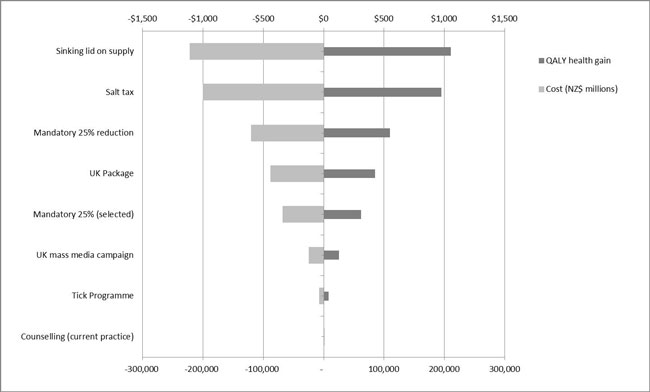 Monday 4 May 2015 3:54pm
Monday 4 May 2015 3:54pm
Associate Professor Nick Wilson
New Otago University research shows that introducing strategies that reduce the dietary salt intake of New Zealanders could reduce premature death and save millions of dollars annually for our health sector.
The study, by researchers from the Department of Public Health, at the University's Wellington campus, also showed that salt reduction strategies would lower heart disease rates in Māori to a higher degree than non-Māori, reducing the current health gap between the populations.
Lead researcher Associate Professor Nick Wilson says dietary sodium (in salt) is a major global disease risk factor—lowering salt lowers blood pressure, which then lowers heart disease and stroke rates.
“The aim of the research was to identify health benefits and cost savings for New Zealanders. We wanted to model the impact of reducing salt in a country that still has a high burden of heart attacks and stroke.”
The researchers found seven of the eight interventions studied produced health gains for New Zealanders and would have overall cost savings for the health sector. The exception was dietary counselling by dietitians, which while it showed it could be good value for money invested, it did not save money overall.
A 'sinking lid' strategy, of reducing the amount of salt over multiple years that is available for the food industry to add into processed food, was found to reap the greatest health benefits and cost savings. This strategy involved reducing the level of sodium from 3500 mg or 1.5 teaspoons of salt per day per person—the current daily salt intake on average for a New Zealand adult—down to 2300 mg of sodium per day (or 1 teaspoon of salt). In total this strategy resulted in an extra 211,000 quality-adjusted life-years for adult New Zealanders over the remainder of their lifetimes.
“For many people this will mean only saving days or weeks of life but for those at risk of heart attacks and strokes in their 50s, the benefits could be measured in decades of extra life,” says Dr Wilson.
Dr Nhung Nghiem, an economist who was involved with the research, says the 'sinking lid' strategy would also save a lot in health dollars.
“It would produce about $1.1 billion in cost savings for our health system from fewer heart attacks and strokes—even when considering that people would live longer and cost the health system more in their extra life.”
Dr Nghiem says the salt tax was the second best strategy and had the advantage of raising revenue, estimated at $450 million per year.
“This extra money could be used to subsidise fruit and vegetables for low-income New Zealanders or help pay for healthy meals in schools,” she says.
Other effective interventions studied included the introduction of a mandatory 25% reduction in sodium levels in all processed foods and a package of salt reduction strategies that have been used in the United Kingdom (including a mass media campaign).
Another strategy that the researchers looked at was The Heart Foundation's tick programme, which was found to be a good investment for reducing salt intake.
Professor Tony Blakely says: “what was new in our study was being able to give results for the New Zealand population using our own disease and cost data. This work was also able to show that the health gain per person was greater for Māori men and women compared to non-Māori—so salt reduction strategies could help reduce the health gaps by ethnicity.”
Dr Wilson says the research supported other international studies that reported major health benefits and more efficient use of health dollars from lowering salt intake.
“Policymakers should be particularly interested in salt reduction interventions as they can often be achieved with food industry cooperation—as seen with the past success in reducing salt in bread in New Zealand.”
“In fact because people's taste buds adapt, it is possible to lower salt in processed food by about 10% a year with virtually no one noticing. While salt reduction strategies would help improve health in adults there is also a need to tackle child obesity as well by following other countries with a tax on sugar-sweetened beverages.”
“The evidence relating to dietary salt and health is still regarded by some people to be controversial but when you look at the body of scientific evidence as a whole there is a strong relationship between high salt intakes and heart disease and stroke,” says Dr Wilson.
The study, funded by the Health Research Council of New Zealand, was published recently in the international peer-reviewed journal PLoS One.
For further information, contact:
Associate Professor Nick Wilson
Department of Public Health
University of Otago, Wellington
Tel 04 385 5541 x6469
Email Nick.Wilson@otago.ac.nz
A list of Otago experts available for media comment is available elsewhere on this website.
Electronic addresses (including email accounts, instant messaging services, or telephone accounts) published on this page are for the sole purpose of contact with the individuals concerned, in their capacity as officers, employees or students of the University of Otago, or their respective organisation. Publication of any such electronic address is not to be taken as consent to receive unsolicited commercial electronic messages by the address holder.Editor's notes
The study was published in the international peer-reviewed journal PLoS One and is available for free on their website.
The health gains reported in this study (measured in quality-adjusted life-years) and costs in this study were all discounted at 3% per annum. For example, discounting at 3% means that $1 earned in 10 years' time is worth 74 cents at the current value, in 20 years 54 cents, in 40 years 30 cents, and so on. Such discounting is standard practice in economic analyses. But in scenario analyses in the published paper we also considered no discounting and 6% discount rate.
Figure: Impact of different interventions to reduce dietary salt intake in the New Zealand population – showing large health gains and also large financial savings to the health system
Notes: The mandatory 25% reduction is for the sodium level in all processed foods. For "selected" foods, this is just for bread, processed meats and sauces.
QALY: quality-adjusted life-years gained from the intervention (by reducing heart attacks and strokes).
